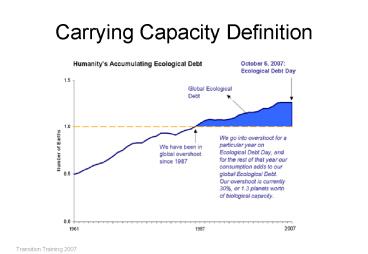Carrying Capacity Definition PowerPoint PPT Presentation
1 / 6
Title: Carrying Capacity Definition
1
Carrying Capacity Definition
Transition Training 2007
2
Carrying capacity - notes
- Main points
- Carrying capacity is the population that can be
sustained, at a given level of consumption, on a
given area - The global population passed the planets
carrying capacity in about 1980 - Additional Notes
- What the carrying capacity is depends on how much
natural resource is taken by humans, how much we
allow for other species - The current human population of the earth is 6.5
billion. Best estimates are that earths long
term sustainable population is 2 billion (if
everyone had a low level of Western consumption
and technology), and maybe less. - Quote from Vandana Shiva the best way for a
population to make good decisions about carrying
capacity is for the people to own their land.
3
Ecological footprint
Transition Training 2007
4
Ecological footprint
- Wackernagel and Rees introduced the concept of
ecological footprints. - The idea can be applied to any item, person or
activity - The footprint is the total area required to
sustainably supply all the energy and resources
needed, and to absorb all the waste produced by
the item, person or activity
5
The UK living beyond our means
ghost acres taking from others
fossil acres taking from the past (ancient
sunlight)
draw down taking from the future
Transition Training 2007
6
Overshoot
- Main Point
- If we are living beyond our means ecologically
speaking How is that possible? - Because we use three sources of extra inputs and
waste removal - Ghost acres. We import food, trees, clothing,
minerals and other resources as raw or finished
goods from other countries. - Fossil acres. Our one-off legacy from the past,
mainly in the form of fossil fuels for energy
but also the most easily mined metals and other
minerals - Draw down. We use renewable resources without
regard to the time for them to renew. We pass on
an increasingly degraded world to our children
with less water, forest, fish, wilderness, trees,
species, land etc - Additional Points
- Ghost acres can be seen as a post-colonial form
of empire taking from those less powerful than
us. The other two are like a business using up
its capital as if it is income. The Last hours
of ancient sunlight is a wonderful book about
this. - In exchange for importing goods and exporting
waste to other countries? We provide services
such as financial markets, and sell debt. 97 of
the money circulating in the world is debt,
issued by rich countries
7
Global inequality is growing
Transition Training 2007
8
Global inequality
- Main points
- Each horizontal band shows 20 of the worlds
population, the horizontal width shows their
income - The richest 20 earn 82 of the worlds income
and the vast majority of this is earned by the
top 10 - Additional points
- This trend is becoming more extreme.
9
A diagram of everything
Transition Training 2007
10
A diagram of everything
Main Point The model of the industrialised growth
system is that there are unlimited resources as
inputs and an unlimited sink for receiving
outputs - waste Although we focus on climate
change and peak oil and some people have
questions about the analysis of these problems, a
closer look reveals that every part of this
system is in crisis. (following slides go into
each aspect in more detail)
11
The solution closing the loops
Transition Training 2007
12
The solution closing the loops
- This slide shows the concept of thinking in terms
of cycles - Solutions to our disconnected resources in
rubbish out system would include ideas such as - Relocalisation the output from one system is an
input somewhere else. E.g. waste card as biofuel - Permaculture is a very helpful thinking tool for
designing closed systems - Indigenous living systems also show us how to
close these loops - You might like to think of some examples of
closing loops..
13
The Age of Cheap Energy is Over
- Peaks in oil production follow peaks in
discoveries- usually 25-40 years later - Of 98 producers, 64 countries have already peaked
- When Peak Oil Climate Change are considered
together, solutions to each cancel each other
out. The whole system needs to be redesigned- a
low energy, re-localised and resilient system is
the only viable future - The current human population of the earth is 6.5
billion. Best estimates are that earths long
term sustainable population is 2 billion (if
everyone had a low level of Western consumption
and technology), and maybe less.

